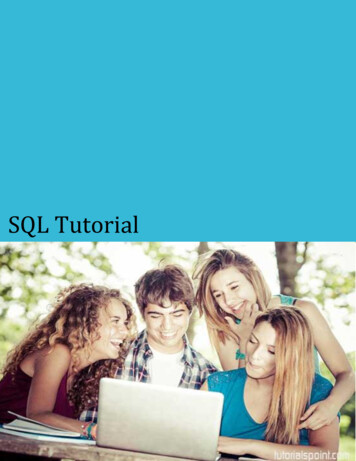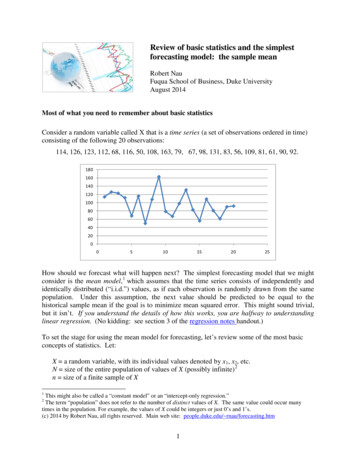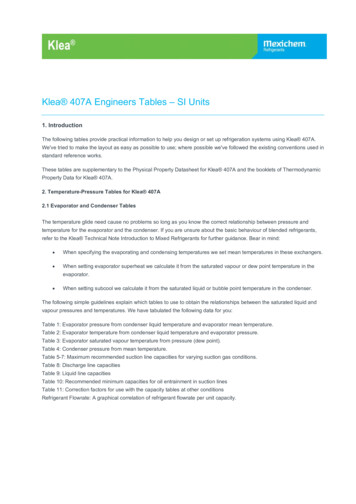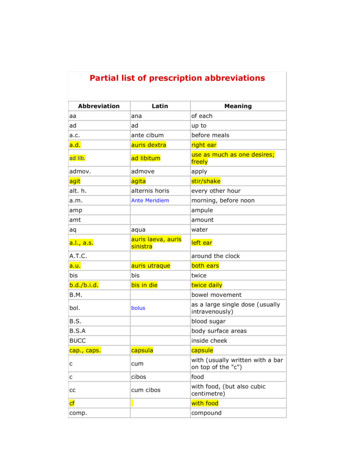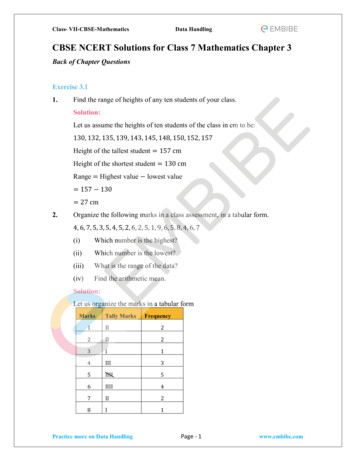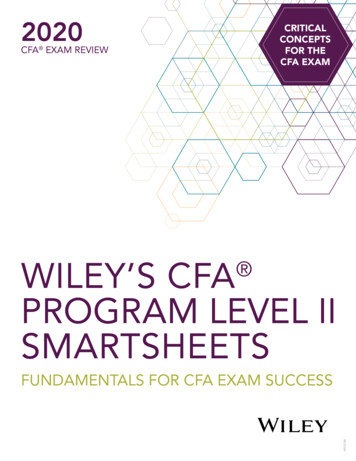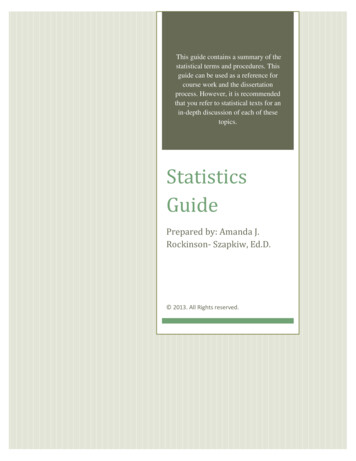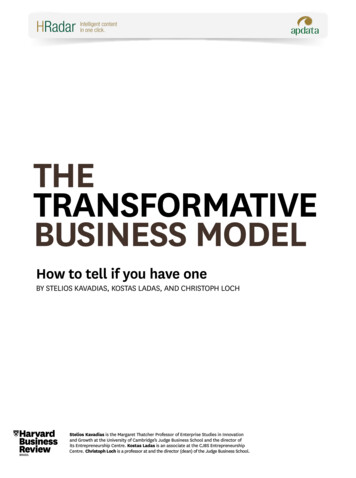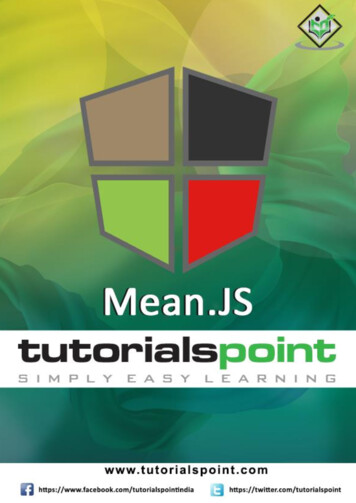
Transcription
MEAN.JSi
MEAN.JSAbout the TutorialThe term MEAN.js refers to full stack JavaScript framework, used for building dynamicwebsitesandwebapplications. MEAN isanacronymthatstandsfor MongoDB, Express, Node.js and AngularJS, which are the key components of theMEAN stack.AudienceThis tutorial is designed for software programmers who want to learn the basics of MEANjsand its programming concepts in simple and easy ways. This tutorial will give you enoughunderstanding on components of MEANjs with suitable examples.PrerequisitesBefore proceeding with this tutorial, we are assuming that you are already aware of thebasics of HTML, CSS, and JavaScript.Copyright & Disclaimer Copyright 2019 by Tutorials Point (I) Pvt. Ltd.All the content and graphics published in this e-book are the property of Tutorials Point (I)Pvt. Ltd. The user of this e-book is prohibited to reuse, retain, copy, distribute or republishany contents or a part of contents of this e-book in any manner without written consentof the publisher.We strive to update the contents of our website and tutorials as timely and as precisely aspossible, however, the contents may contain inaccuracies or errors. Tutorials Point (I) Pvt.Ltd. provides no guarantee regarding the accuracy, timeliness or completeness of ourwebsite or its contents including this tutorial. If you discover any errors on our website orin this tutorial, please notify us at contact@tutorialspoint.comii
MEAN.JSTable of ContentsAbout the Tutorial . iiAudience . iiPrerequisites . iiCopyright & Disclaimer . iiTable of Contents . iii1.MEAN.JS ― Overview . 1What is MEAN.js? . 1History . 1Why to use MEAN.js? . 1Introduction to MongoDB . 1Introduction to Express . 2Introduction to AngularJS . 2Introduction to Node.js . 22.MEAN.JS — Architecture . 3BUILD NODE WEB APP . 63.MEAN.JS — MEAN Project Setup . 7Prerequisites . 7Creating Express Project . 7Running Application . 104.MEAN.JS ― Building Static Route Node Express . 12Setting Up Routes . 12Running Application . 125.MEAN.JS ― Build Data Model . 14Adding Mongoose to Application . 14Setting up Connection File. 156.MEAN.JS ― REST API . 18iii
MEAN.JSRESTful API Routes . 18FRONT END WITH ANGULAR . 237.MEAN.JS — Angular Components in App . 24Getting to know AngularJS . 24Angular Application as a Module. 24Defining Controller . 25Defining Scope . 258.MEAN.JS ― Building Single Page with Angular . 27Setting Up Our Angular Application . 27Bower and Pulling in Components . 27Angular Controllers. 29Angular Routes . 29View File . 30Running Application . 319.MEAN.JS — Building an SPA: The next level . 33Defining Frontend Route . 36Running Application . 39iv
1. MEAN.JS ― OverviewMEAN.JSWhat is MEAN.js?The term MEAN.js is a full stack JavaScript open-source solution, used for buildingdynamic websites and web applications. MEAN is an acronym that standsfor MongoDB, Express, Node.js and AngularJS, which are the key components of theMEAN stack.It was basically developed to solve the common issues with connecting those frameworks(Mongo, Express Nodejs, AngularJS), build a robust framework to support dailydevelopment needs, and help developers use better practices while working with popularJavaScript components.Stack means using the database and web server in the back end, in the middle you willhave logic and control for the application and interaction of user at the front end. MongoDB: Database System Express: Back-end Web Framework Node.js: Web Server Platform AngularJS: Front-end FrameworkHistoryMEAN name was coined by Valeri Karpov, a MongoDB developer.Why to use MEAN.js? It is an open source framework which is free to use. It can be used as standalone solution in a whole application. It provides lower development cost and increases the developer flexibility andefficiency. It supports MVC pattern and uses the JSON for transferring data. It provides additional frameworks, libraries and reusable modules to increase thedevelopment speed.Before we begin with further concepts, we will see the basic building blocksof MEAN.JS application.Introduction to MongoDBIn MEAN acronym, M stands for MongoDB, which is an open source NoSQL database thatsaves the data in JSON format. It uses the document oriented data model to store thedata instead of using table and rows as we use in the relational databases. It stores data1
MEAN.JSin binary JSON (JavaScript Serialized Object Notation) format to pass the data easilybetween client and server. MongoDB works on concept of collection and document. Formore information, refer to this link.Introduction to ExpressIn MEAN acronym, E stands for Express, which is a flexible Node.js web applicationframework used to make development process easier. It is easy to configure andcustomize, that allows building secure, modular and fast applications. It specifies theroutes of an application depending on the HTTP methods and URLs. You can connect todatabases such as MongoDB, MySQL, Redis easily. For more information, refer to this link.Introduction to AngularJSIn MEAN acronym, A stands for AngularJS, which is a web frontend JavaScript framework.It allows creating dynamic, single page applications in a clean Model View Controller (MVC)way. AngularJS automatically handles JavaScript code suitable for each browser. For moreinformation, refer to this link.Introduction to Node.jsIn MEAN acronym, N stands for Node.js, which is a server side platform used fordevelopment of web applications like video streaming sites, single-page applications, andother web applications. It provides a rich library of various JavaScript modules whichsimplifies the development of web applications using Node.js to a great extent. It is builton Google Chrome's V8 JavaScript Engine, so it is very fast in code execution. For moreinformation, refer to this link.2
2. MEAN.JS — ArchitectureMEAN.JSMEAN is an open source JavaScript framework, used for building dynamic websites andweb applications. It includes following four building blocks to build an application. MongoDB: It is a document database, that stores data in flexible, JSON-likedocuments. Express: It is web application framework for Nodejs. Node.js: It is Web Server Platform. It provides rich library of various JavaScriptmodules which simplifies the development of web applications. AngularJS: It is a web frontend JavaScript framework. It allows creating dynamic,single page applications in a clean Model View Controller (MVC) way.For more information on these, you can refer the overview chapter. The below diagramdepicts architecture of MEAN stack application.3
MEAN.JSAs shown in the above image, we have AngularJS as client side language which processesthe request of a client. Whenever a user makes a request, it is first processed by AngularJS. Next, request enters second stage, where we have Node.js as server side languageand ExpressJS as backend web framework. Node.js handles the client/server requests and ExpressJS makes request to thedatabase.4
MEAN.JS In the last stage, MongoDB (database) retrieves the data and sends the responseto ExpressJS. ExpressJS returns the response to Nodejs and in turn to AngularJS and thendisplays the response to user.5
MEAN.JSBuild Node Web App6
3. MEAN.JS — MEAN Project SetupMEAN.JSThis chapter includes creating and setting up a MEAN application. We are using NodeJSand ExpressJS together to create the project.PrerequisitesBefore we begin with creating a MEAN application, we need to install requiredprerequisites.You can install latest version of Node.js by visiting the Node.js websiteat https://nodejs.org/ (This is for Windows users). When you download Node.js, npm willget installed automatically on your system. Linux users can install the Node and npm byusing this link.Check the version of Node and npm by using the below commands: node --version npm --versionThe commands will display the versions as shown in the below image:Creating Express ProjectCreate a project directory by using mkdir command as shown below: mkdir mean-demo //this is name of repositoryThe above directory is the root of node application. Now, to create package.json file, runthe below command: cd webapp-demo npm initThe init command will walk you through creating a package.json file:This utility will walk you through creating a package.json file. It only covers the mostcommon items, and tries to guess sensible defaults.7
MEAN.JSSee npm help json for definitive documentation on these fields and exactlywhat they do.Use npm install --save afterwards to install a package and save it as adependency in the package.json file.Press C at any time to quit.name: (mean-demo) mean tutorialversion: (1.0.0)description: this is basic tutorial example for MEAN stackentry point: (index.js) server.jstest command: testgit repository:keywords: MEAN,Mongo,Express,Angular,Nodejsauthor: Manishalicense: (ISC)About to write to : "mean tutorial","version": "1.0.0","description": "this is basic tutorial example for MEAN stack","main": "server.js","scripts": {"test": "test"},"keywords": hor": "Manisha","license": "ISC"}8
MEAN.JSIs this ok? (yes) yesClick yes and a folder structure as below will be generated:-mean-demo-package.jsonThe package.json file will have the following info:{"name": "mean tutorial","version": "1.0.0","description": "this is basic tutorial example for MEAN stack","main": "server.js","scripts": {"test": "test"},"keywords": hor": "Manisha","license": "ISC"}Now to configure the Express project into current folder and install configuration optionsfor the framework, use the below command:npm install express --saveGo to your project directory and open package.json file, you will see the belowinformation:{"name": "mean tutorial","version": "1.0.0","description": "this is basic tutorial example for MEAN stack","main": "server.js",9
MEAN.JS"scripts": {"test": "test"},"keywords": hor": "Manisha","license": "ISC","dependencies": {"express": " 4.17.1"}}Here you can see express dependency is added to the file. Now, the project structure isas below:-mean-demo--node modules created by npm install--package.json--server.jstells npm which packages we needset up our node applicationRunning ApplicationNavigate to your newly created project directory and create a server.js file with belowcontents.// modules const express require('express');const app express();// set our portconst port 3000;app.get('/', (req, res) res.send('Welcome to Tutorialspoint!'));// startup our app at http://localhost:3000app.listen(port, () console.log( Example app listening on port {port}! ));10
MEAN.JSNext, run the application with the below command: npm startYou will get a confirmation as shown in the image below:It informs that Express application is running. Open any browser and access the applicationusing http://localhost:3000. You will see Welcome to Tutorialspoint! text as shownbelow:You can download the source code of the above example from here.11
4. MEAN.JS ― Building Static Route NodeExpressMEAN.JSThis chapter demonstrates building route for an application with Node and Express.In the previous chapter, we created a node-express application. Navigate to projectdirectory called mean-demo. Go to the directory by using below command: cd mean-demoSetting Up RoutesRoutes are used as mapping service by using URL of an incoming request. Openthe server.js file and setup the routing as shown below:// modules const express require('express');const app express();// set our portconst port 3000;app.get('/', (req, res) res.send('Welcome to Tutorialspoint!'));//defining routeapp.get('/tproute', function (req, res) {res.send('This is routing for the application developed using Node andExpress.');});// startup our app at http://localhost:3000app.listen(port, () console.log( Example app listening on port {port}! ));Running ApplicationNext, run the application with the below command: npm startYou will get a confirmation as shown in the image below:12
MEAN.JSNow, go to browser and type http://localhost:3000/myroute. You will get the page asshown in the image below:You can download the source code for this application in this link.13
5. MEAN.JS ― Build Data ModelMEAN.JSIn this chapter, we shall demonstrate how to use data model in our Node-expressapplication.MongoDB is an open source NoSQL database that saves the data in JSON format. It usesthe document oriented data model to store the data instead of using table and rows as weuse in the relational databases. In this chapter, we are using Mongodb to build data model.Data model specifies what data is present in a document, and what data should be therein a document. Refer the Official Mongodb installation, to install the MongoDB.We shall use our previous chapter code. You can download the source code in this link.Download the zip file; extract it in your system. Open the terminal and run the belowcommand to install npm module dependencies. cd mean-demo npm installAdding Mongoose to ApplicationMongoose is a data modelling library that specifies environment and structure for the databy making MongoDB powerful. You can install Mongoose as an npm module through thecommand line. Go to your root folder and run the below command: npm install --save mongooseThe above command will download the new package and install it intothe node modules folder. The --save flag will add this package to package.json file.{"name": "mean tutorial","version": "1.0.0","description": "this is basic tutorial example for MEAN stack","main": "server.js","scripts": {"test": "test"},"keywords": ["MEAN","Mongo","Express",14
MEAN.JS"Angular","Nodejs"],"author": "Manisha","license": "ISC","dependencies": {"express": " 4.17.1","mongoose": " 5.5.13"}}Setting up Connection FileTo work with data model,model students.js as below:wewillbeusing app/models folder.Let'screatevar mongoose require('mongoose');// define our students model// module.exports allows us to pass this to other files when it is calledmodule.exports mongoose.model('Student', {name : {type : String, default: ''}});You can setup the connection file by creating the file and using it in the application. Createa file called db.js in config/db.js. The file contents are as below:module.exports {url : 'mongodb://localhost:27017/test'}Here test is the database name.Here it is assumed that you have installed MongoDB locally. Once installed start Mongoand create a database by name test. This db will have a collection by name students.Insert some data to this colection. In our case, we have inserted a record usingdb.students.insertOne( { name: 'Manisha' , place: 'Pune', country: 'India'} );Bring the db.js file into application, i.e., in server.js. Contents of the file are as shownbelow:// modules const express require('express');15
MEAN.JSconst app express();var mongoose require('mongoose');// set our portconst port 3000;// configuration // config filesvar db db);mongoose.connect(db.url); //Mongoose connection created// frontend routes app.get('/', (req, res) res.send('Welcome to Tutorialspoint!'));//defining routeapp.get('/tproute', function (req, res) {res.send('This is routing for the application developed using Node andExpress.');});// sample api route// grab the student model we just createdvar Student ents', function(req, res) {// use mongoose to get all students in the databaseStudent.find(function(err, students) {// if there is an error retrieving, send the error.// nothing after res.send(err) will executeif (err)res.send(err);res.json(students); // return all students in JSON format});});// startup our app at http://localhost:3000app.listen(port, () console.log( Example app listening on port {port}! ));16
MEAN.JSNext, run the application with the below command: npm startYou will get a confirmation as shown in the image below:Now, go to browser and type http://localhost:3000/api/students. You will get thepage as shown in the image below:You can download the source code for this application in the link.17
6. MEAN.JS ― REST APIMEAN.JSIn this chapter, we will see our application interacting via a REST API with our databaseby using HTTP methods. The term REST stands for REpresentational State Transfer, whichis an architectural style designed to communicate with web services and API stands forApplication Program Interface that allows interacting applications with each other.First, we will create RESTful API to get all items, create the item and delete an item. Foreach item, id will be generated automatically by MongoDB. The below table describeshow application should request data from API:HTTPMethodURL PathDescriptionGET/api/studentsIt is used to get all the students from collectionStudent.POST/api/students/sendIt is used to create a student record in collectionStudent.DELETE/api/students/student idIt is used to delete a student record fromcollection Student.RESTful API RoutesWe will first discuss Post Method in RESTful API Routes.POSTFirst let's create a record in the collection Student via our REST API. The code for thisparticular case can be found in server.js file. For reference, a part of code is pasted here:app.post('/api/students/send', function (req, res) {var student new Student();student modelstudent.name req.body.name;request)// create a new instance of the// set the student name (comes from thestudent.save(function(err) {if (err)res.send(err);res.json({ message: 'student created!' });});18
MEAN.JS});ExecutionYou can download the source code for this application in this link. Download the zip file;extract it in your system. Open the terminal and run the below command to install npmmodule dependencies. cd mean-demon-consuming rest api npm installTo parse the request, we would need body parser package. Hence, run the below commandto include in your application.npm install --save body-parserThe attached source code already has this dependency, hence no need to run the abovecommand, it is just for your info.To run the application, navigate to your newly created project directory and run with thecommand given below:npm startYou will get a confirmation as shown in the image below:There are many tools to test the API calls, here we are using one of the user friendlyextensions for Chrome called Postman REST Client.OpenthePostmanRESTClient,entertheURLas http://localhost:3000/api/students/send, select the POST method. Next, enterrequest data as shown below:19
MEAN.JSNotice that we are sending the name data as x-www-form-urlencoded. This will send allof our data to the Node server as query strings.Click on the Send button to create a student record. A success message will appear asshown below:GETNext, let’s get all the student records from the mongodb. Following route needs to bewritten. You can find full code in server.js file.app.get('/api/students', function(req, res) {20
MEAN.JS// use mongoose to get all students in the databaseStudent.find(function(err, students) {// if there is an error retrieving, send the error.// nothing after res.send(err) will executeif (err)res.send(err);res.json(students); // return all students in JSON format});});Next,openthePostmanRESTClient,enteras http://localhost:3000/api/students, select the GET methodthe Send button to get all the students.theURLand click onDELETENext, let's see how to delete a record from our mongo collection via REST api call.Following route needs to be written. You can find full code in server.js file.app.delete('/api/students/:student id', function (req, res) {Student.remove({id: req.params.student id}, function(err, bear) {21
MEAN.JSif (err)res.send(err);res.json({ message: 'Successfully deleted' as faa61146d (here5d1492fa74f1771faa61146d is the record we will be deleting from the collection Student).Select the DELETE method and click on the Send button to get all the students.You can check the MongoDB for theto akingGETcall22
MEAN.JSFront End with Angular23
7. MEAN.JS — Angular Components in AppMEAN.JSIn this chapter, we will add angular components to an application. It is a web front endJavaScript framework, which allows creating dynamic, single page applications by usingModel View Controller (MVC) pattern. In the MEAN.JS architecture chapter, you have seenhow AngularJS will process the client request and get the result from database.Getting to know AngularJSAngularJS is an open-source web application framework that uses HTML as templatelanguage and extends the HTML's syntax to express your application components clearly.AngularJS provides some basic features such as data binding, model, views, controllers,services etc. For more information on AngularJS, refer to this link.You can make the page an Angular application by adding Angular in the page. It can beadded just by using an external JavaScript file, which can be either downloaded or can bereferenced directly with a CDN version.Consider we have downloaded file and referenced it locally by adding to the page asfollows: script src "angular.min.js" /script Now, we need to tell Angular that this page is an Angular application. Therefore, we cando this by adding an attribute, ng-app to the html or body tag as shown below: html ng-app or body ng-app The ng-app can be added to any element on the page, but it is often put into the html or body tag so that Angular can work anywhere within the page.Angular Application as a ModuleTo work with an Angular application, we need to define a module. It is a place where youcan group the components, directives, services, etc., which are related to the application.The module name is referenced by ng-app attribute in the HTML. For instance, we will sayAngular application module name as myApp and can be specified in the html tag asshown below: html ng-app "myApp" We can create definition for the application by using below statement in an externalJavaScript file:24
MEAN.JSangular.module('myApp', []); //The [] parameter specifies dependent modules inthe module definitionDefining ControllerAngularJS application relies on controllers to control the flow of data in the application. Acontroller is defined by using ng-controller directive.For instance, we will attach the controller to the body by using ng-controller directive,along with name of the controller you want to use. In the below line, we are using nameof the controller as "myController". body ng-controller "myController" You can attach a controller (myController) to an Angular module (myApp) as shown ller', function() {// controller code here});It is better to use named function instead of an anonymous function for readability, reusability, and testability. In the below code, we are using new named function"myController" to hold the controller code:var myController function() {// controller code ller', myController);For more information on controllers, refer to this link.Defining ScopeScope is a special JavaScript object that connects controller with views and contains modeldata. In controllers, model data is accessed via scope object. The controller functiontakes scope parameter which has been created by Angular and it gives direct access tothe model.The below code snippet specifies how to update controller function to receivethe scope parameter and sets the default value:var myController function( scope) {25
MEAN.JS scope.message "Hello World.";};For more information on controllers, refer to this link. In the next chapter, we will startcreating single page application by using Angular.26
8. MEAN.JS ― Building Single Page with AngularMEAN.JSIn the MEAN stack, Angular is known as second JavaScript framework, which allowscreating single page applications in a clean Model View Controller (MVC) way.AngularJS as a front-
MEAN.JS 1 What is MEAN.js? The term MEAN.js is a full stack JavaScript open-source solution, used for building dynamic websites and web applications. MEAN is an acronym that stands for MongoDB, Express, Node.js and AngularJS, which are the key components of the MEAN stack. It was basically developed to



